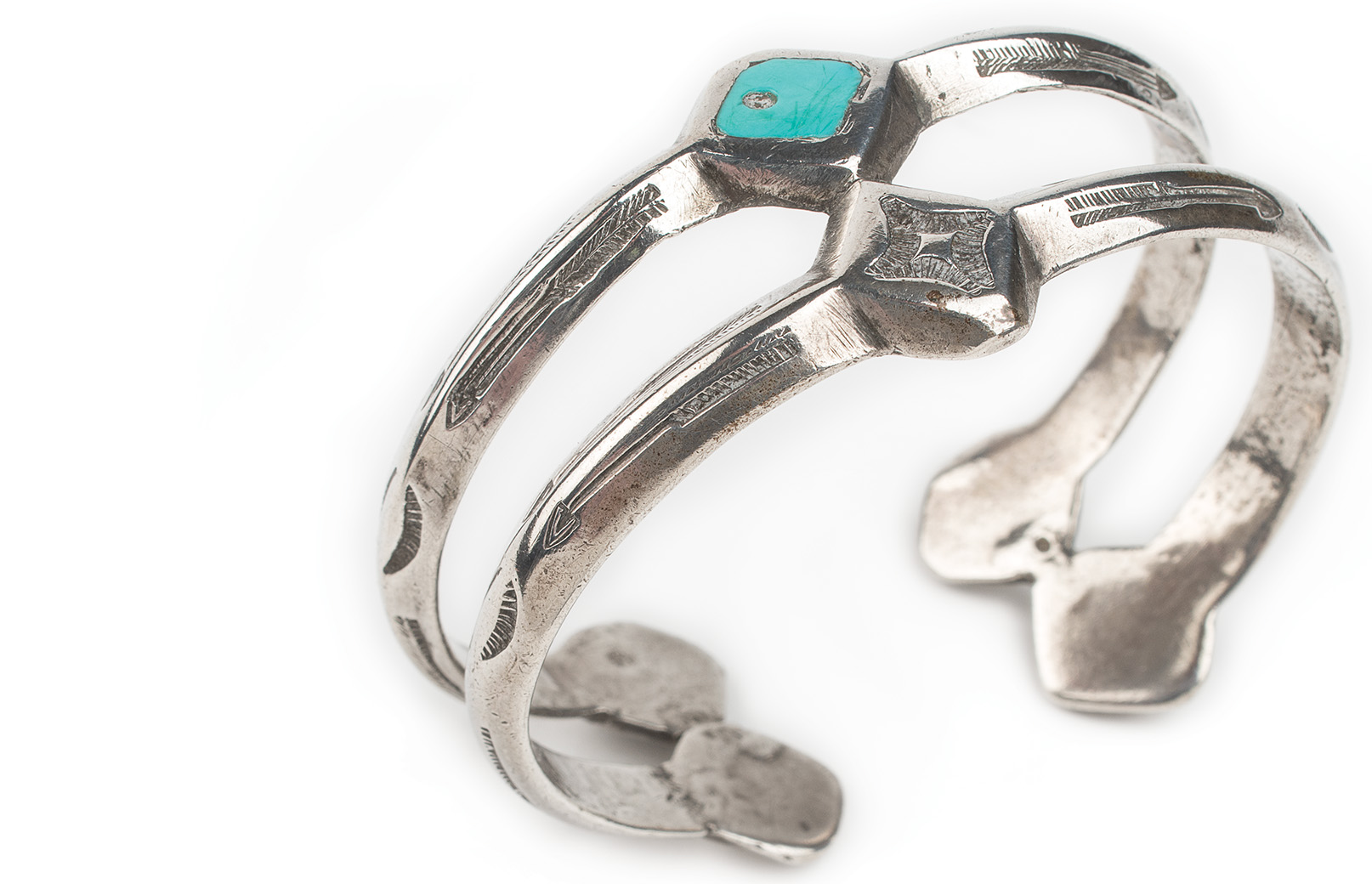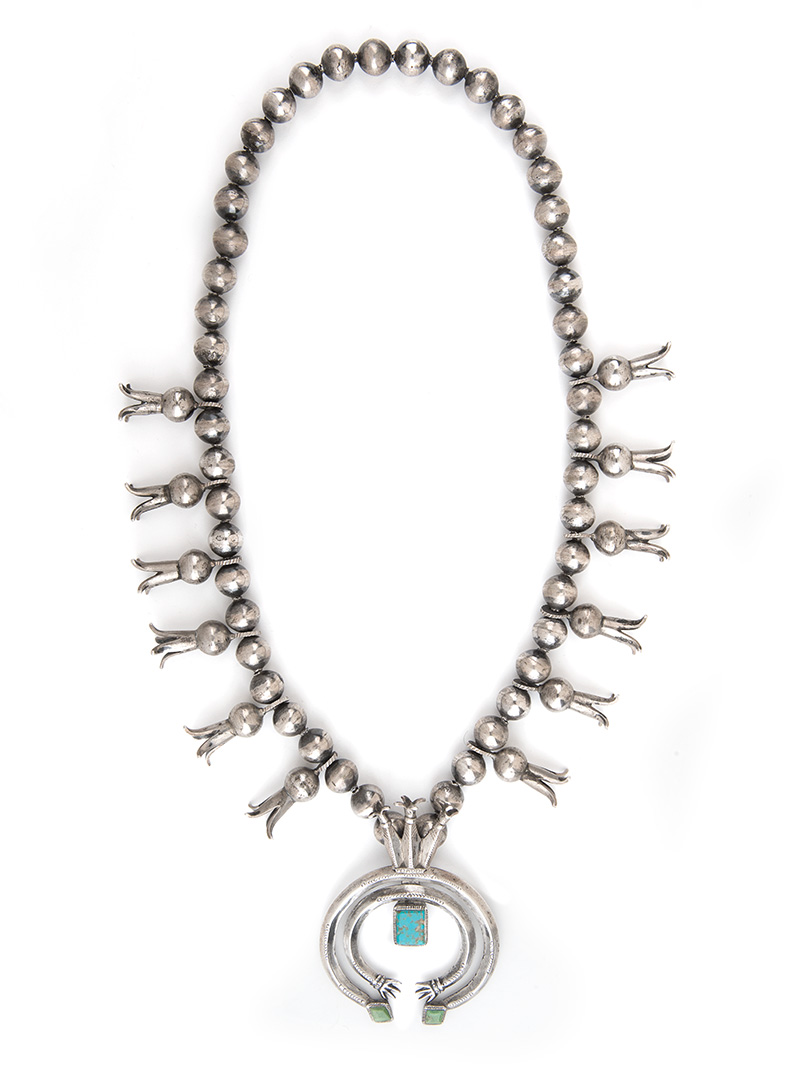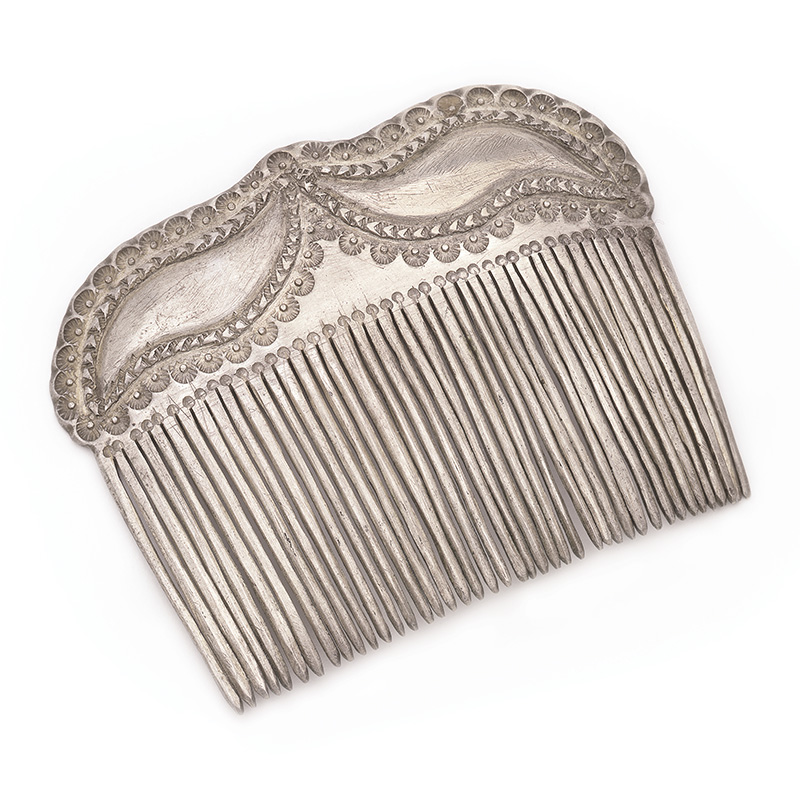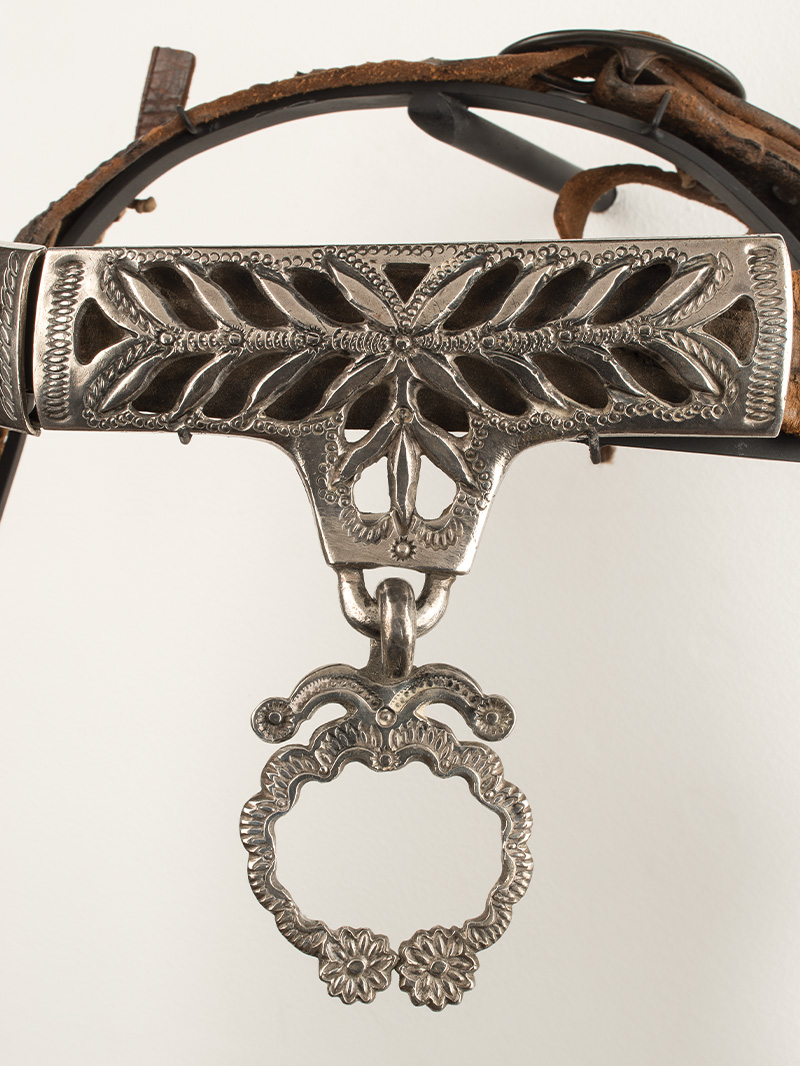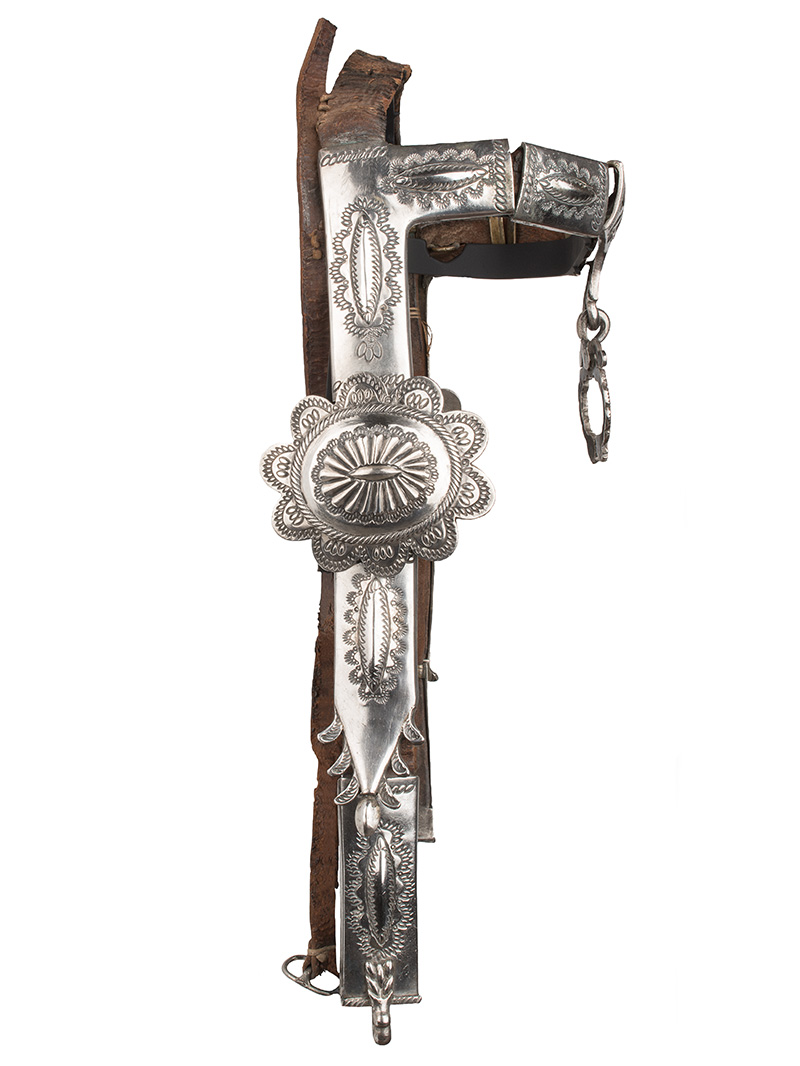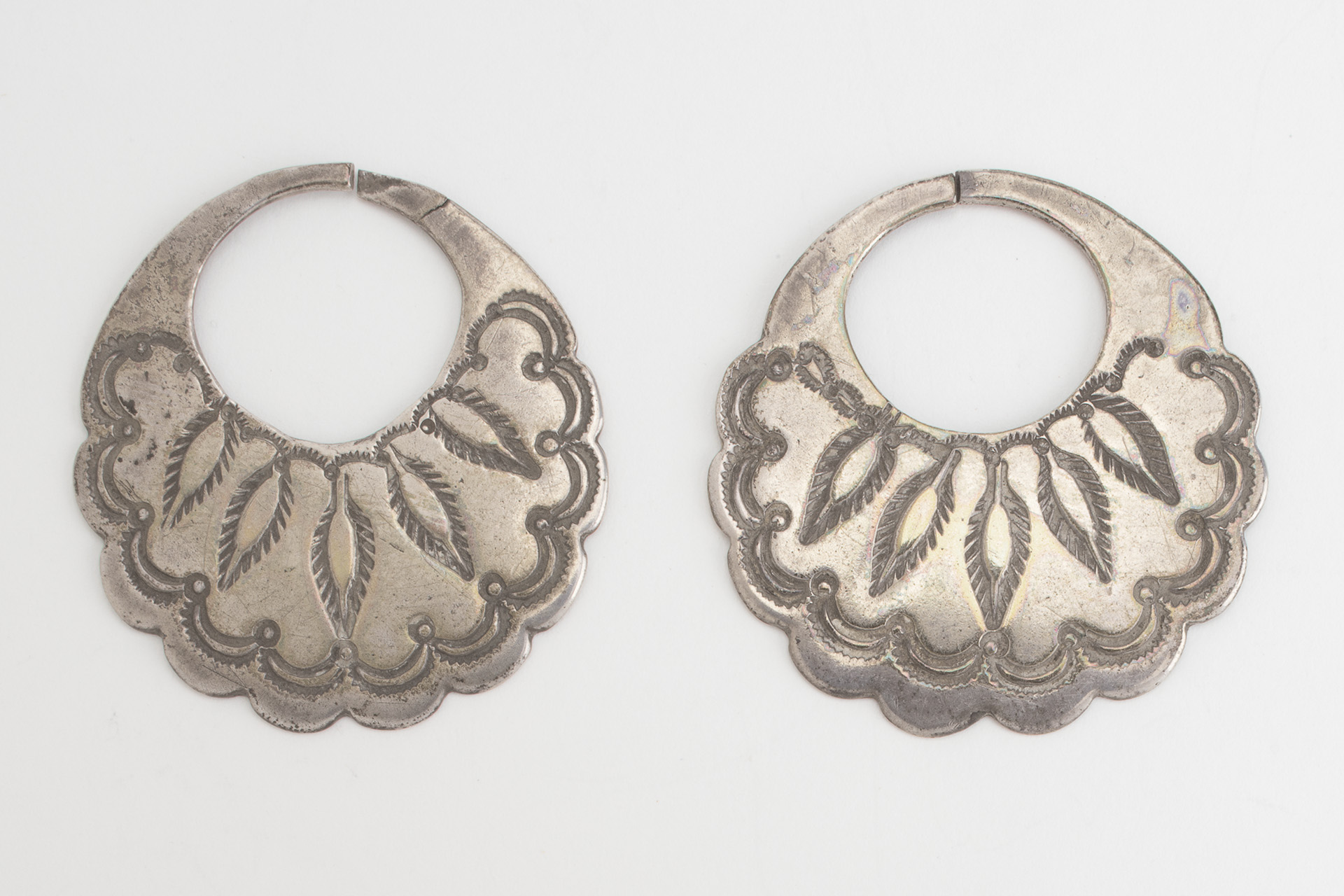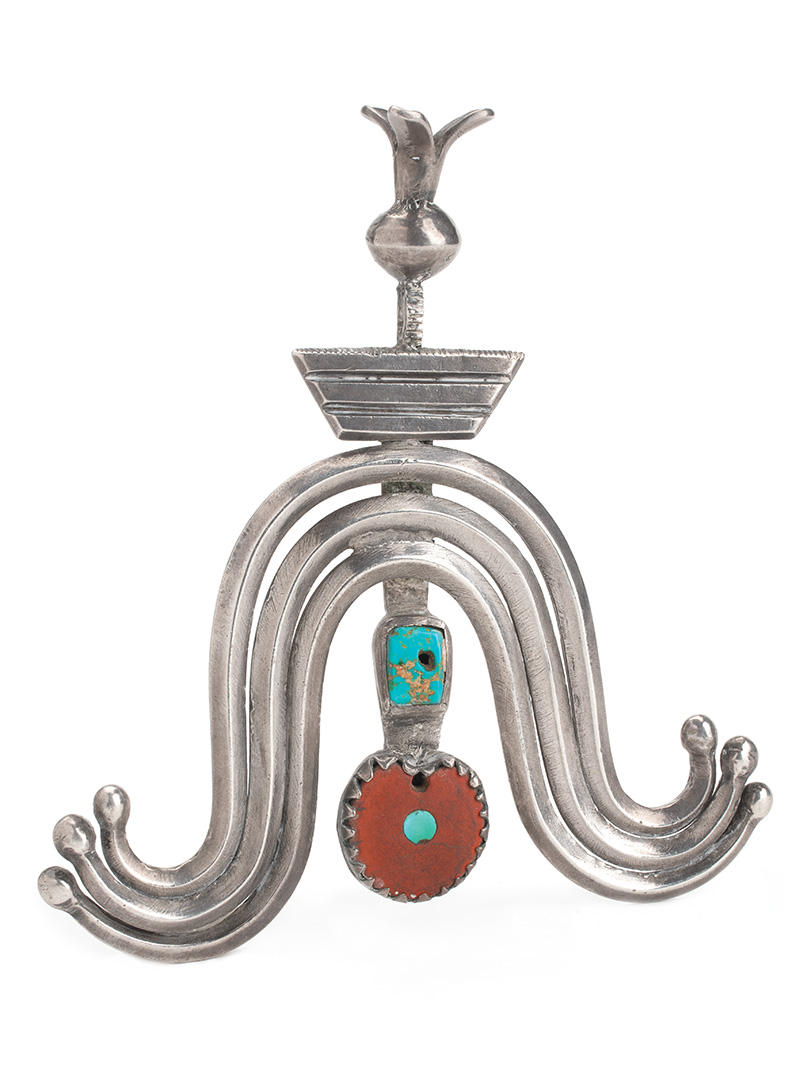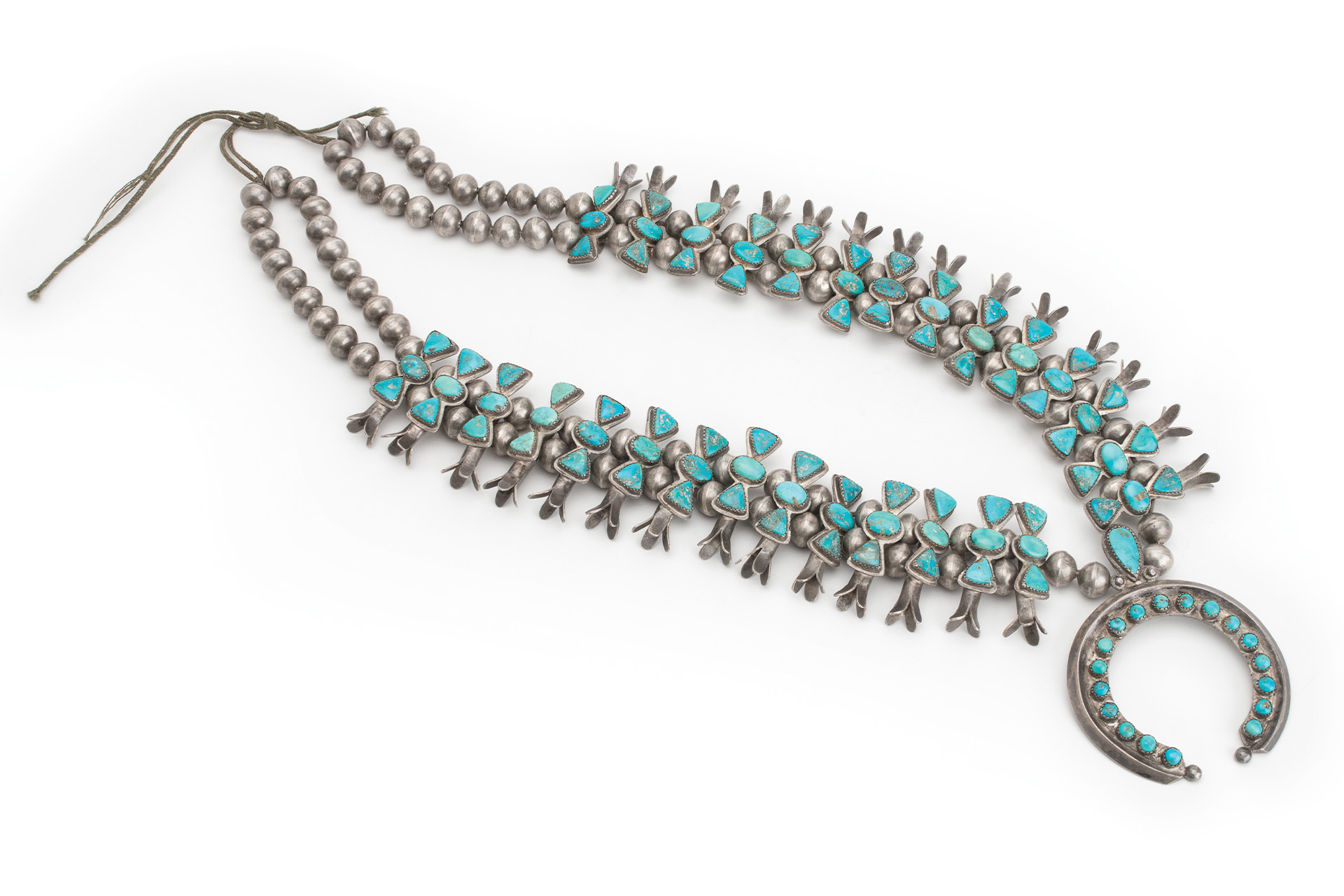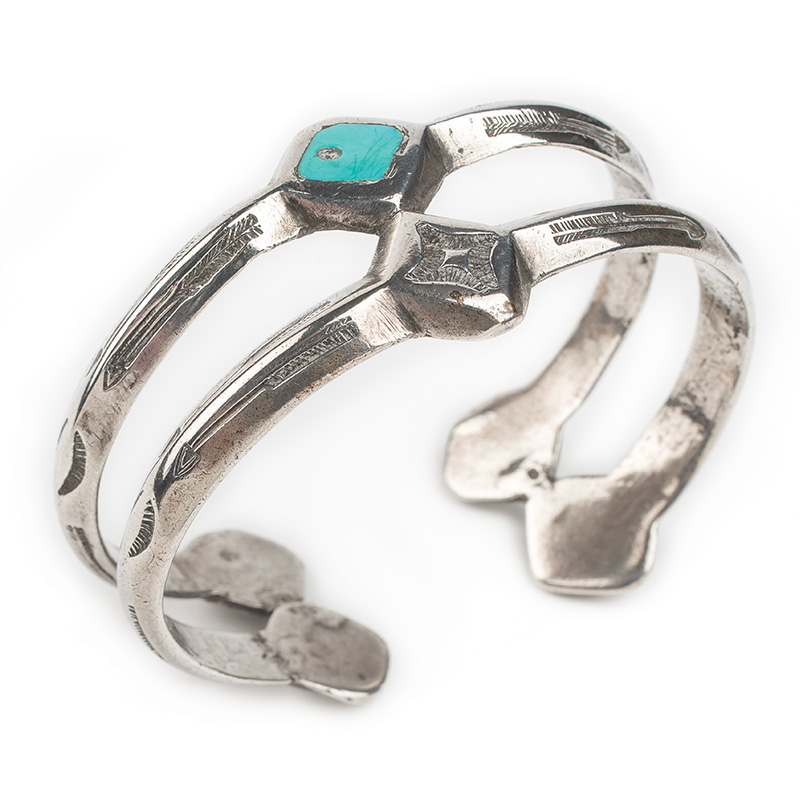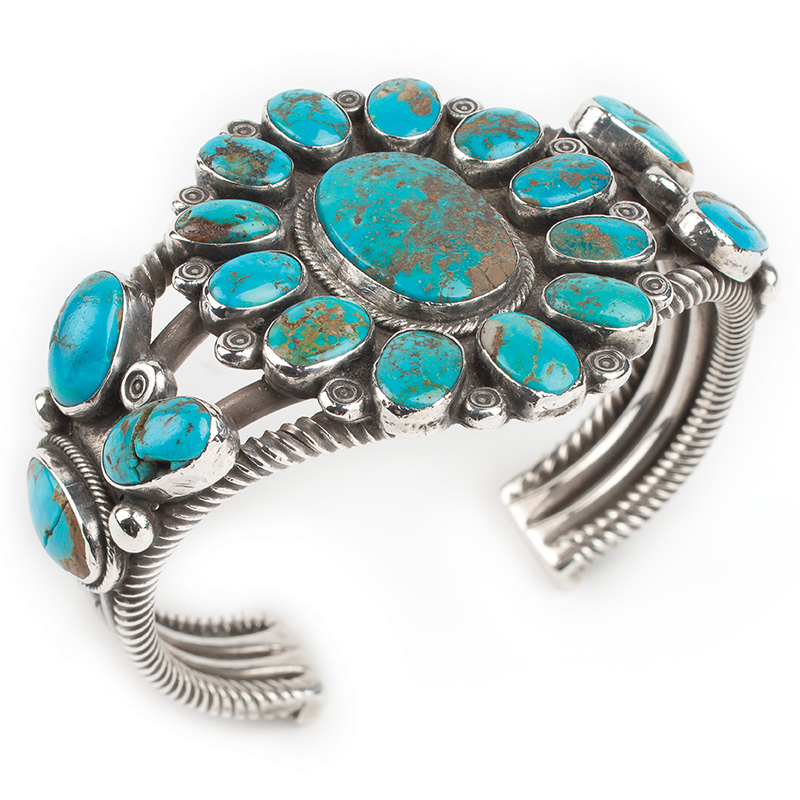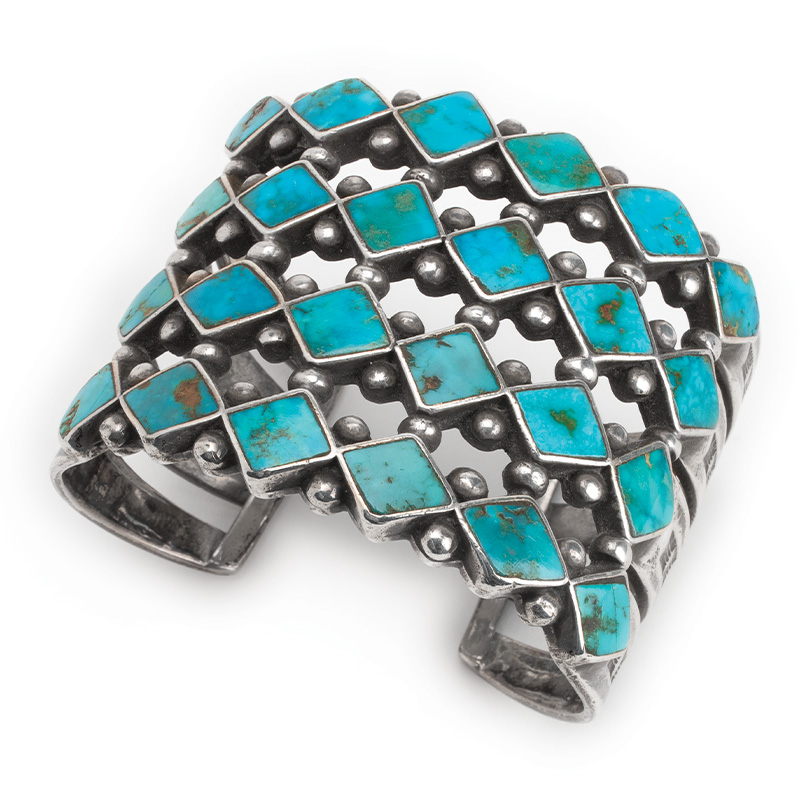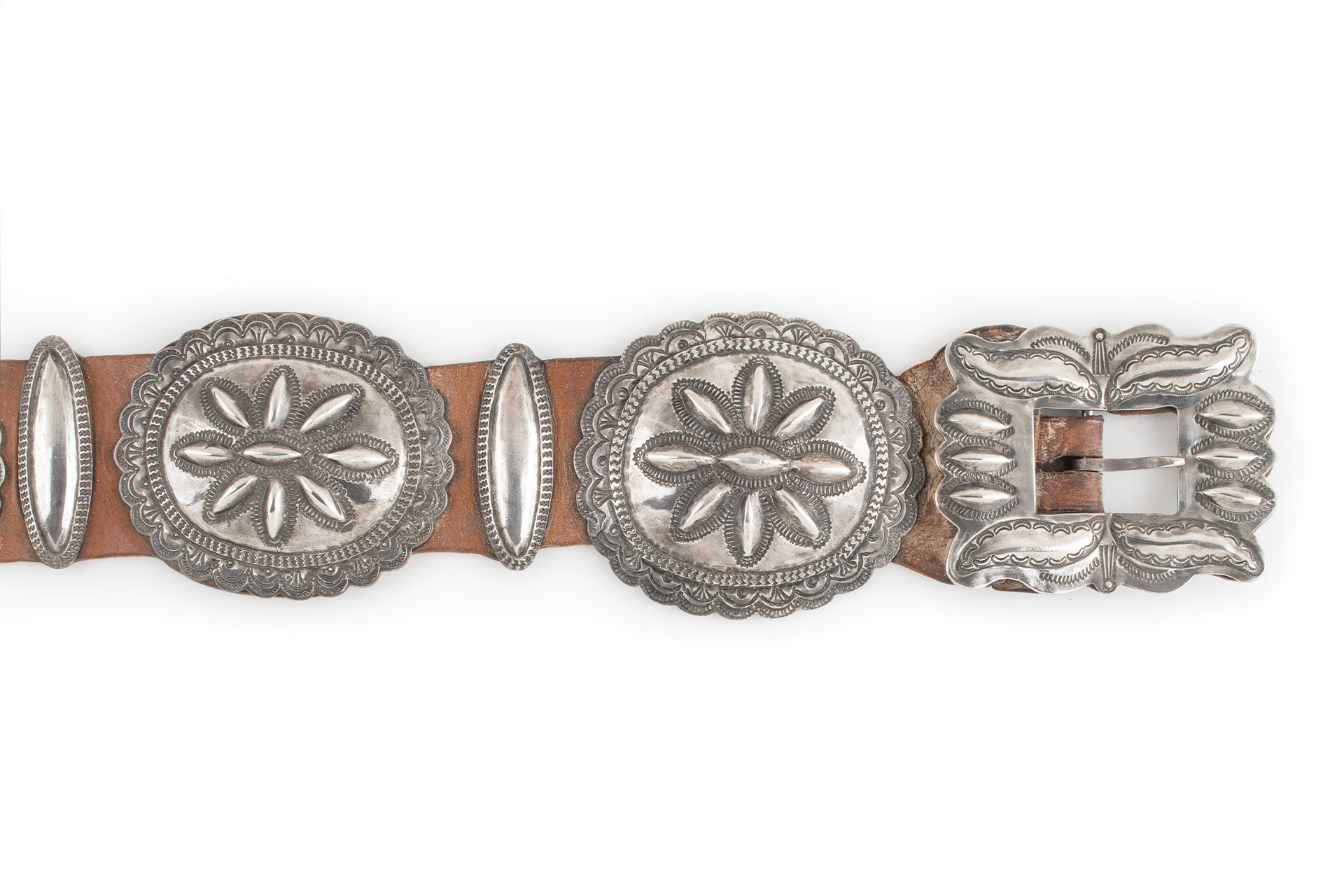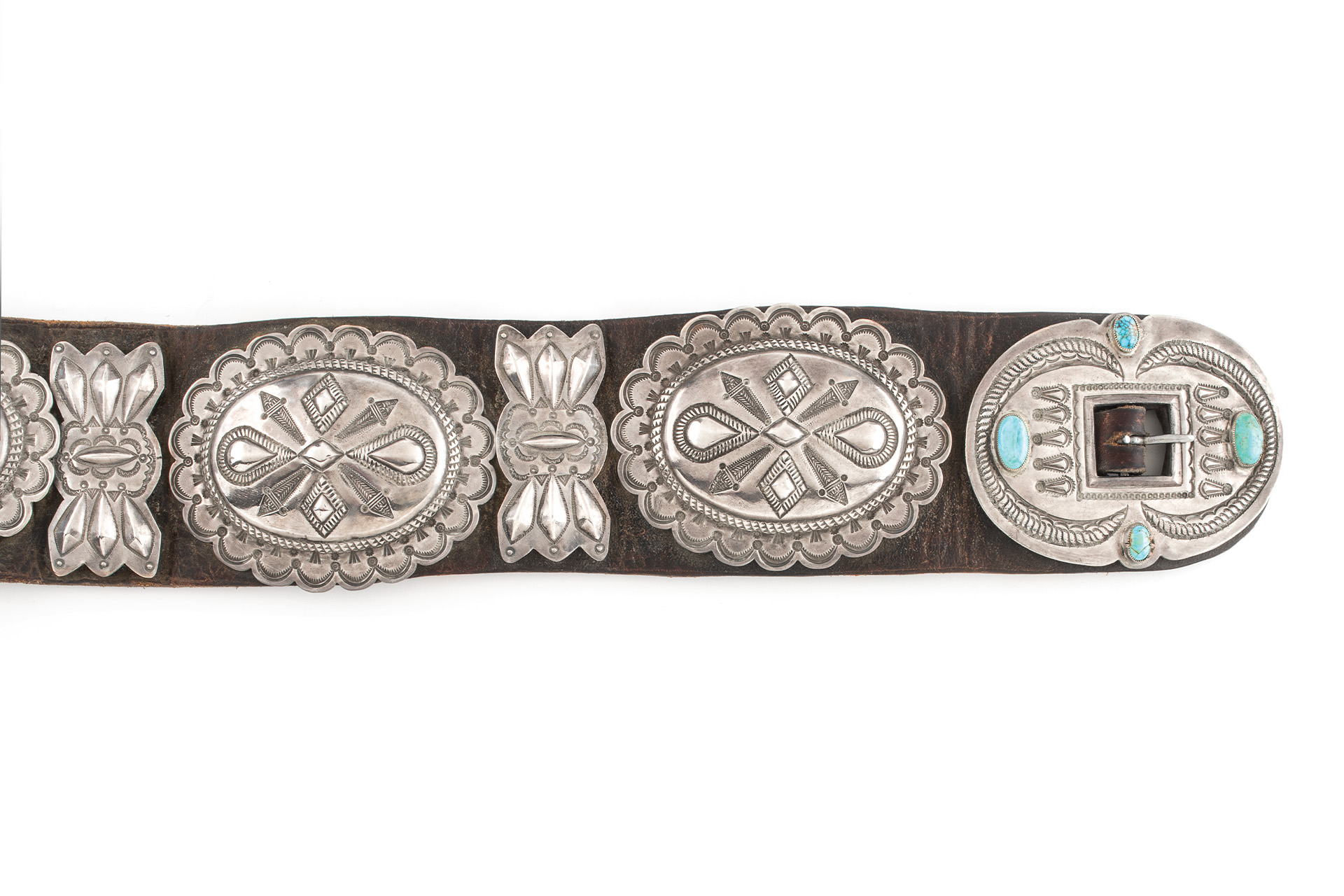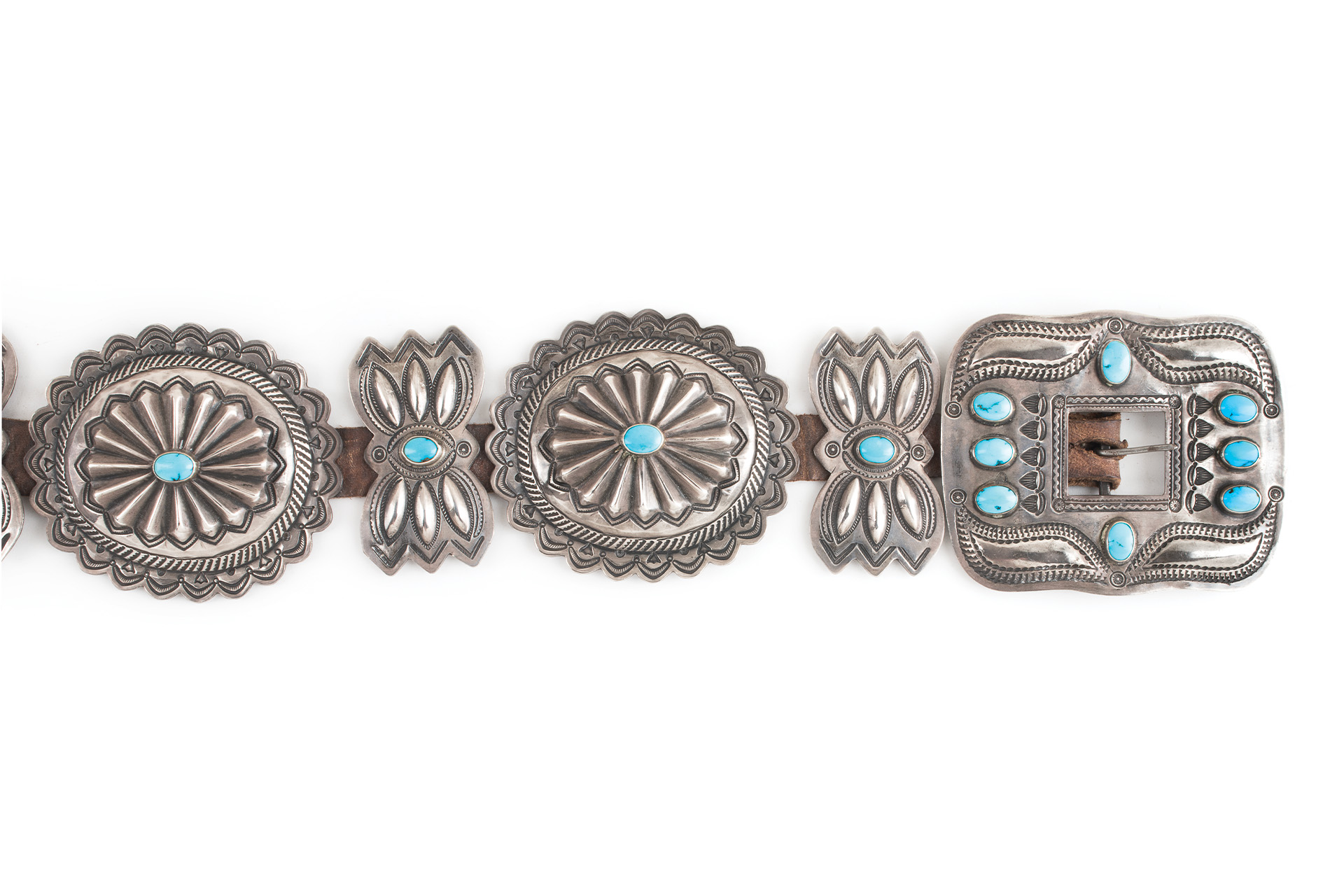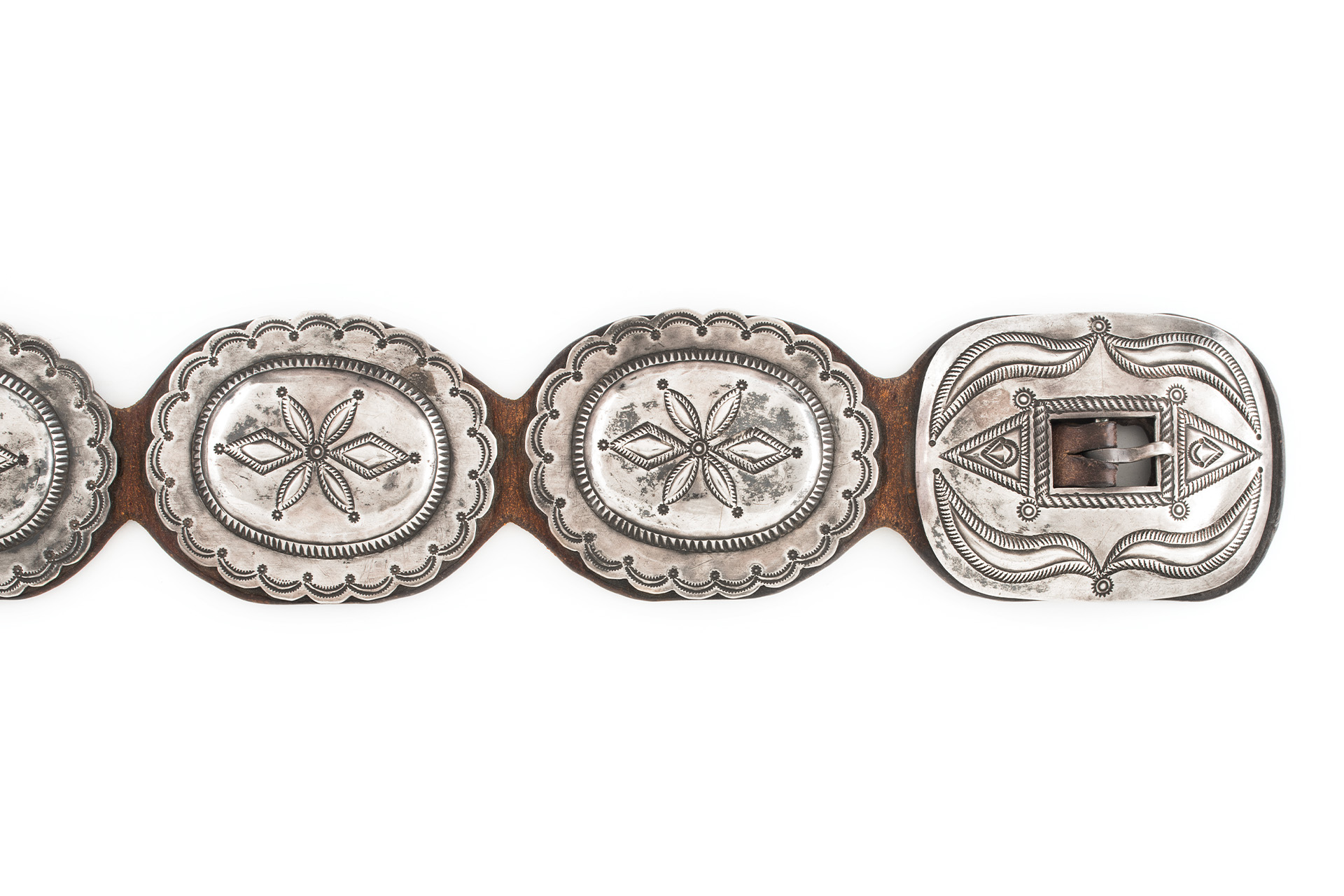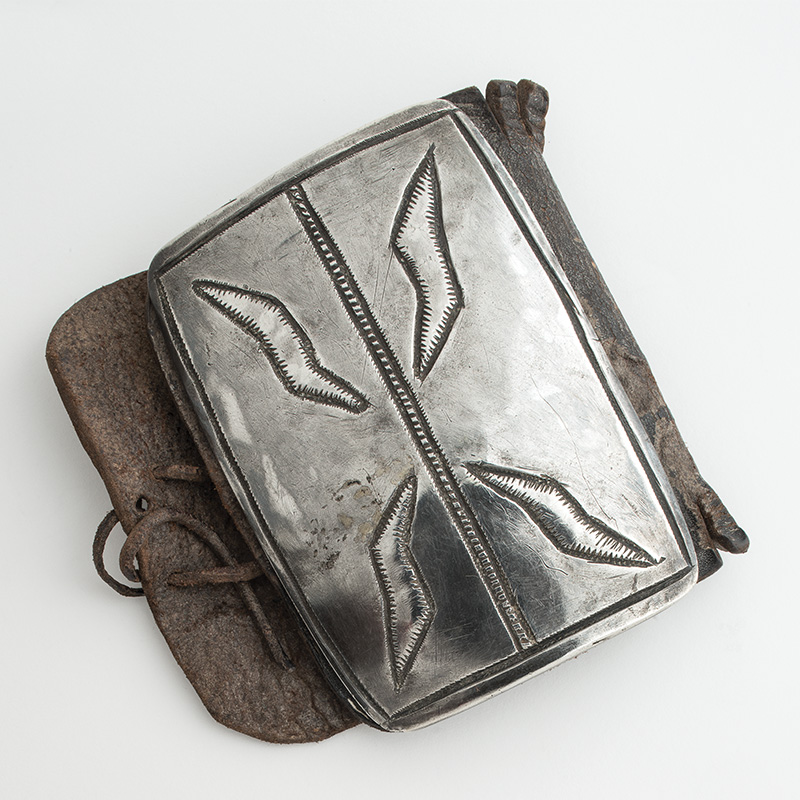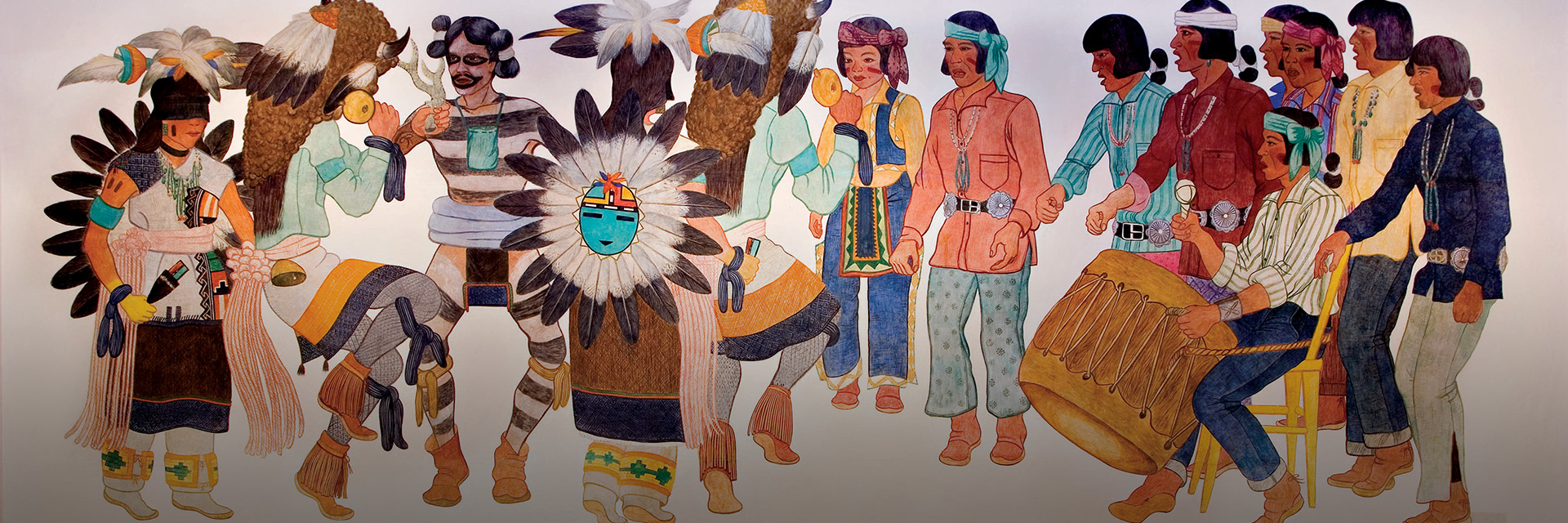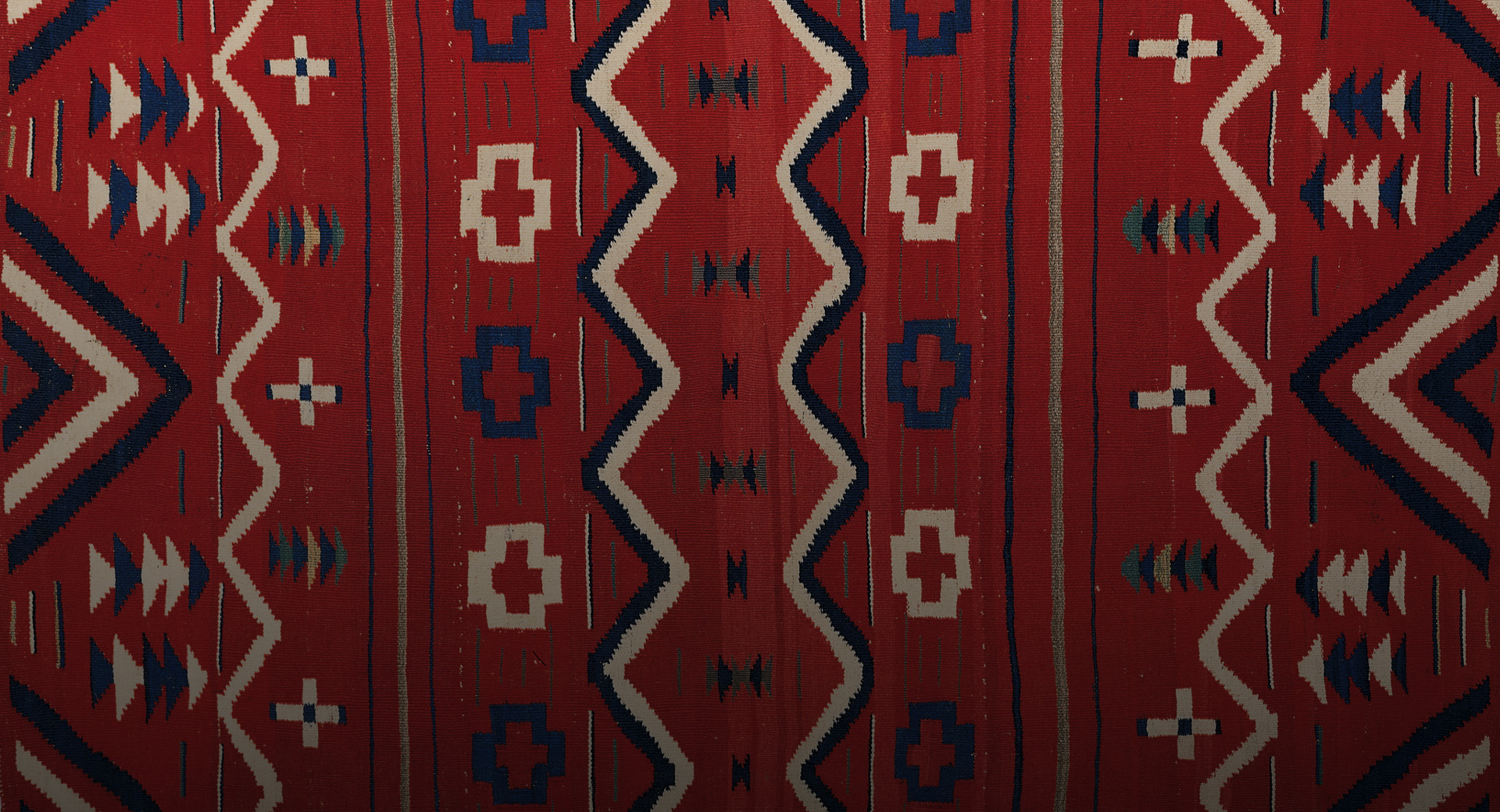Robert Bauver, guest curator
By the 1800s, metal in all its various forms became integral to Native culture. Iron and steel, introduced through European contact, quickly became part of the necessities of daily life. But it was silver, the metal of the moon, that captured the attention of Native populations. As early as 1795, the governor of New Mexico recorded Navajo people wearing silver jewelry.
Dating back to the 1500s, Franciscan friars made sporadic references to Native American attempts at ironwork. In the mid-1830s, two blacksmiths, Ramon Sena of Santa Fe and José Castillo, were engaged by Navajo men to instruct them in the rudiments of blacksmithing. Using dendrochronology, archaeologists have verified two sites bearing evidence of Navajo smiths dating to 1830 and 1846.
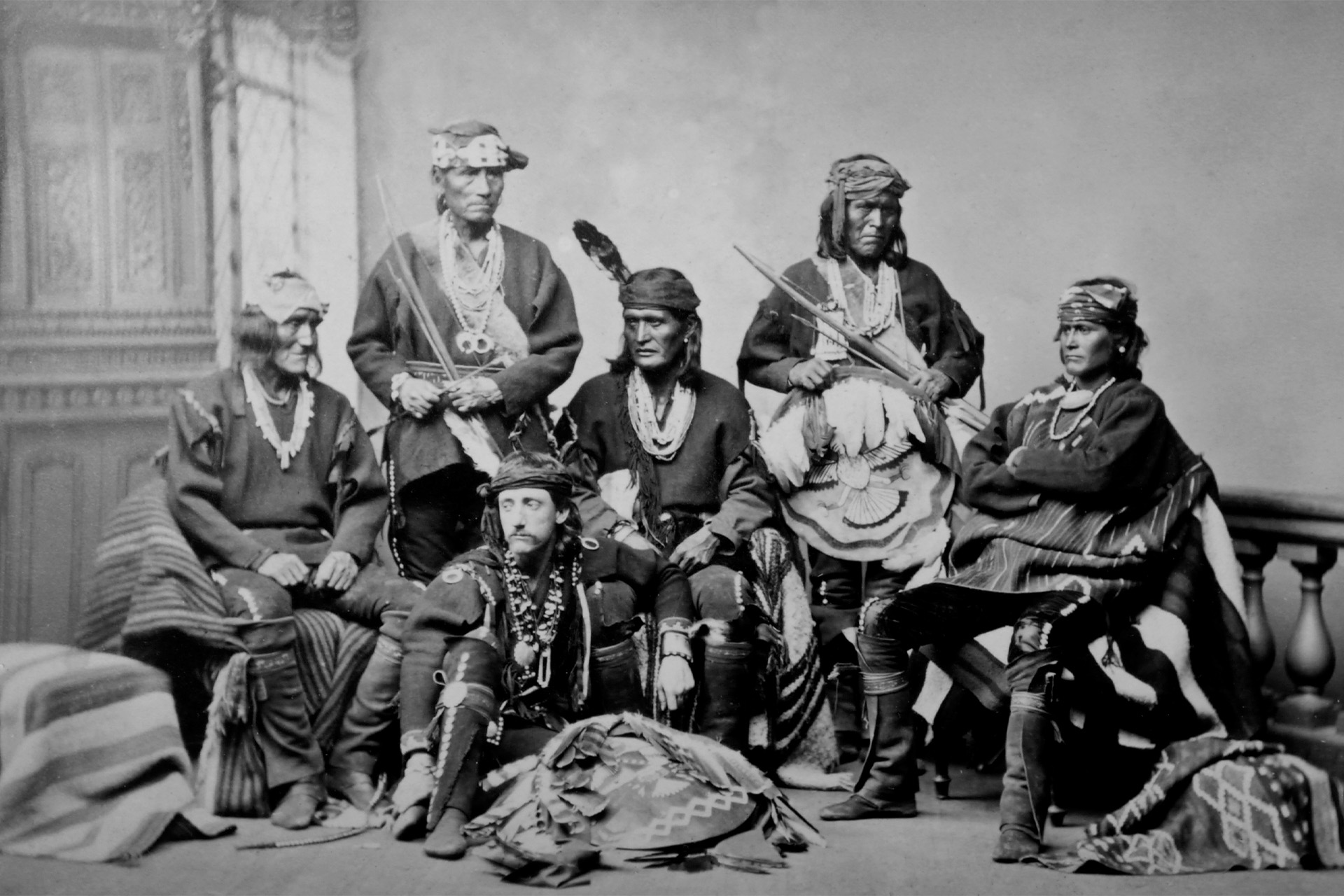
In 1853, Lieutenant Henry Dodge established a Navajo agency at Washington Pass, bringing with him a blacksmith and a Mexican silversmith. A Navajo headman named Herrero, later called Atsidi Sani, credited with being the first Navajo silversmith, came by “to look on and learn some things.” By 1855, W.W. Davis observed a leather belt highly ornamented with silver being worn. Belts fitting this description can be seen in lithograph illustrations made during 1857 for the Colorado Exploring Expedition, a topographical and navigational survey of the Colorado River.
The ensuing years brought warfare and incarceration to the Navajo people. While the Navajo were confined at Bosque Redondo from 1864 to 1868, military reports recorded observations of Navajo skills in both iron and silver working. An 1864 report describes an incident in which aNavajo chief had his “silver belt worth one hundred dollars stolen … theft traced to … soldiers.” In 1868, the Navajo were allowed to return home as an impoverished nation, and Navajo skills in weaving and the beginnings of silverwork were noted, encouraged and promoted by local traders. The following decades saw Southwest Native arts flourish and gain recognition as an international art form.
Initially, in the early 1800s, limited blacksmithing was practiced among the Navajo and Pueblo people. By the 1850s and 1860s, some of these early blacksmiths were turning their attention to silverwork as well, applying their existing skills in ironwork. Evidence of this can be seen in the shared techniques appearing on items made of iron and silver. For example, chisels used in blacksmithing were impressed into silver to create simple decorative elements. Smiths also began using their ironwork punches, stamps and files on their early silver items.
Navajo artisan Atsidi Sani, who worked with iron before becoming a silversmith, made bridle bits out of scrap iron. He made them with jingles hanging from the bottom. The smaller units of jingle pendants at the sides of the bit were called zarcillos, the Spanish word for earrings. These may have influenced later silver earring designs.
The Navajo smiths’ proficiency in working iron was apparent in their abilities to design and fabricate increasingly intricate stamps out of iron tools, such as nails and files. Through time, the stamps grew in size and complexity and became the primary method of decorating silver. Silver was never mined by Native people of the Southwest; their source of silver was old Spanish and Mexican coins. In the 1870s, traders imported pesos that were melted down for use; later, American coins were used. When both countries outlawed the defacing of their currency, traders sought out a refinery in California that would supply 1-ounce squares of silver, which they provided to smiths.
Silver coins were easily turned into buttons. Crafting larger jewelry pieces involved melting and casting the required amount of silver into a rectangular or disk-formed ingot. These could then be forged into the desired object shape. Uneven forging often resulted in cracked silver, requiring repairs and patches.
An alternative method to hammering an ingot into a shape was to cast the form. In 1879, Dr.Washington Matthews observed molten silver poured into open-faced stone molds. Sand casting, learned from the Mexican plateros (silversmiths), involved tightly packing a frame with finely grained sand into which the desired form and pouring channel was cut. Then, backed with a similar frame of sand or a flat stone, the silver was poured into the cavity. Later, the same technique was employed using locally obtained volcanic tufa. Fine grained, easily carved and heat resistant, tufa was found to be a superior material for casting. Allowing more intricately designed work and capable of yielding multiple castings from the same mold, tufa quickly became the medium of choice as opposed to the sand method, which required a new mold from each casting.
Bridles
Navajo silver mounted head stalls are a direct adaptation of a type used by neighboring horse culture tribes living on the Southern Plains. Their bridles of German silver or brass were based on a Spanish design produced by Mexican smiths working at Bent’s Fort in Colorado as trade items to the Plains groups. These trade bridles were based on Spanish/Mexican silver bridles, often fashioned with a round side buckle through which a silver-tipped strap was passed, allowing the bridle to be adjusted to fit the horse. As some Plains groups gained a rudimentary knowledge of metalwork, copying Spanish horse gear, they lacked the technical skills needed to recreate the buckle mechanism. Maintaining its position on the bridle, the buckle was replaced with a simple round concho. The now-unused belt tip was lengthened and gained placement asa purely decorative unit. These bridles would in turn serve as the model for the first Navajo smiths to reproduce in silver.
Early Navajo bridles emulated the wide, flat pattern of Plains styles decorated with uncomplicated designs along the borders. The designs were made by rocker engraving, a method using a narrow, flat-edged tool that is pushed over the surface of the silver and rocked continually to create a zigzag line. Navajo smiths added a simple crescent-shaped pendant (naja) from the bridle frontlet, the central forehead unit. In the creative hands of the Navajo smiths, bridle styles evolved along with the design and technical advances seen in the jewelry being produced and would appear in the unprecedented forms seen here. Silver mounted headstalls fell into disuse in the 20th century. Many would see the removal of the naja for use elsewhere, most likely on necklaces.
Earrings
One of the earliest forms of personal adornment, earrings, existed in the American Southwest long before European contact. Bits of colored stone, shell or bone were drilled and shaped into ear pendants, with turquoise being the most favored. Mosaic earrings worn at the Zuni and Hopi pueblos date back to the pre-contact era. Exclusively worn by women, these earrings are said to represent “blue corn stacked up.” The long loops of discoidal turquoise beads, called jaclas, a name derived from a Navajo term for ear rope, have been worn by both genders. They are also worn as pendants on necklaces.
In the mid-1800s, copper, brass and later silver wire were formed into large hoops. Adding silver beads to the hoops resulted in such weight that observers noted the wearers hooking the earrings over their ears while riding horses. The chiseled lines in one pair of wire hoops reflect the same approach to decoration seen on very early bracelets made in the 1870s. At times, the lower portion of the hoop was flattened and decorated with stamped designs or turquoise settings. Lanyade, the first silversmith at Zuni, stated that he made many pairs of the type described in the 1890s.
The elongated cones with pendant pomegranates seem to be a style particular to Pueblo peoples. They are possibly derived from silver ornaments that were attached to Spanish capes. Many cone-shaped earrings were made at Isleta Pueblo, and some date to 1879.
Once Native smiths gained the ability to set turquoise into silver in about 1880, turquoise was used in every form of jewelry. As turquoise sources were limited, necklace beads were often repurposed for settings. What started out of necessity became, for a short period, a style in the 1920s-30s. Drilled beads were set in earrings and bracelets and occasionally enhanced with silver filling the drill holes. A style unique to Zuni documented in the mid-1920s consisted of “flat hoops set with turquoise discs which showed from each side.” In the following decade, earrings especially would reflect the increasing skills in silverwork and stone cutting in both the imagination and diversity of styles produced.
Necklaces
Native people wore necklaces they crafted of shell and stone beads for centuries beforeEuropean contact. Spanish explorers introduced “fine coral beads,” which are still favored today. From 1864 to 1868, military officials stationed with the exiled Navajo at Bosque Redondo reported Navajo men making silver buttons, some of which were strung together to fashion necklaces.
The squash blossom necklace as we know it today developed over a period of time. Long necklaces of round silver beads were observed in the late 1870s. Commonly, these had a single-or double-barred cross pendant. Beads with crescent-shaped pendants appeared on necklace sin about 1880. At about the same time, Native smiths began to set turquoise and other stones in jewelry. Many imaginative stories have been attached to the squash blossoms. None seem true when considering that the Navajo word for them translates to “bead that flares out.” The downward curving pendant common on silver necklaces and bridles has been called a naja by the Navajo people, their word for crescent. Many false stories, myths and legends have been attached to it, alleging a spiritual connection to Navajo ceremonialism. To the Native inhabitants of the Southwest, it is simply an article of jewelry.
This basic form has a history dating back into antiquity, when Bucephalus, the steed ofAlexander the Great, bore a crescent-shaped blaze on his forehead. In deference to the great horse and rider, many Mediterranean cultures adopted the form as a bridle ornament. It arrived in Spain with the Moors and from there traveled to the Americas, eventually arriving on the Southern Plains in the mid-1800s and into the lives of the Navajo.
In the 1870s, silver najas based on the bridle ornament began to be added to necklaces and became part of the evolving styles of Navajo dress. In the 1880s, najas were observed suspended from the shoulders and belts of wearers. The basic naja form still appears in various in carnations, most frequently as the focal point on necklaces. Throughout the history of the craft, najas were fashioned from both hammered and cast silver. The original crescent became more elaborate as it kept pace with advances in silverwork design and techniques.
Bracelets
Bracelets appear in greater variation than any other form of Native jewelry. In the Southwest in the 1840s, observers noted copper and brass being used as simple bracelet forms. When heavy copper wire became available in the early 1860s, it was “pounded up into bracelets” by Navajo people before and during their time at Fort Sumner at Bosque Redondo, from about 1864 to 1868. In the late 1870s, Navajo people would trade sheep for copper wire right off the spool.Formed into simple open-ended bangles or C-shaped bracelets, the wire was left plain or decorated with a series of chiseled or filed lines in a chevron motif at the center with a reduced version repeated at the ends. As silver became more plentiful, this type of bracelet shape and design was replicated in the preferred metal. In fact, this concept of design placement, also seen in early blanket designs, was maintained well into the 20th century, even as jewelry evolved into far more elaborate styles. Though silver assumed prominence in jewelry, use of copper and brass did not completely die out. Combined with silver and turquoise, examples could be seen as late as the early 1940s.
Silver wire bracelets were shaped into triangular cross section as well and worn in great numbers. In 1881, U.S. Army Lieutenant John G. Bourke reported that Native women were wearing 10 or 11 on each wrist. By the second half of the 1880s, stamp work was being applied to flat bracelets. Loose bangles, often with a central length of twisted wires, were soldered together at the distal ends to serve as the foundation for larger bracelets set with turquoise. Heavy cast-silver ingots were hammered out and then chiseled lengthwise and filed with grooves, replicating the appearance of stacked bangles. Casting allowed silversmiths to produce intricate bracelets that were difficult to create using other methods.
Setting turquoise and other stones into bracelets and other jewelry forms began in the 1880s. By the 1890s, it was a widespread practice. Flat Native-cut turquoise and some locally found garnets encased in silver mountings to hold the stones, known as bezels, were common additions to every form of jewelry. It is not uncommon to see previously unset pieces of jewelry from this period updated with stones added over existing stamp work.
Native populations knew about the rich turquoise deposits in the American Southwest long before European contact. Native mining procured a limited supply of the precious stones. The popularity, and at the time scarcity, of the favored turquoise prompted traders to importPersian turquoise stones. Native stone workers began emulating the high-domed Persian cutting technique. By 1900, stones were rising above the setting. To satisfy the growing interest in Southwest silver and turquoise jewelry, modern mining interests started supplying turquoise on a commercial scale. In the 1920s, the abundance of rough and polished stones obtained by smiths could be combined in multiple settings on a single piece of jewelry.
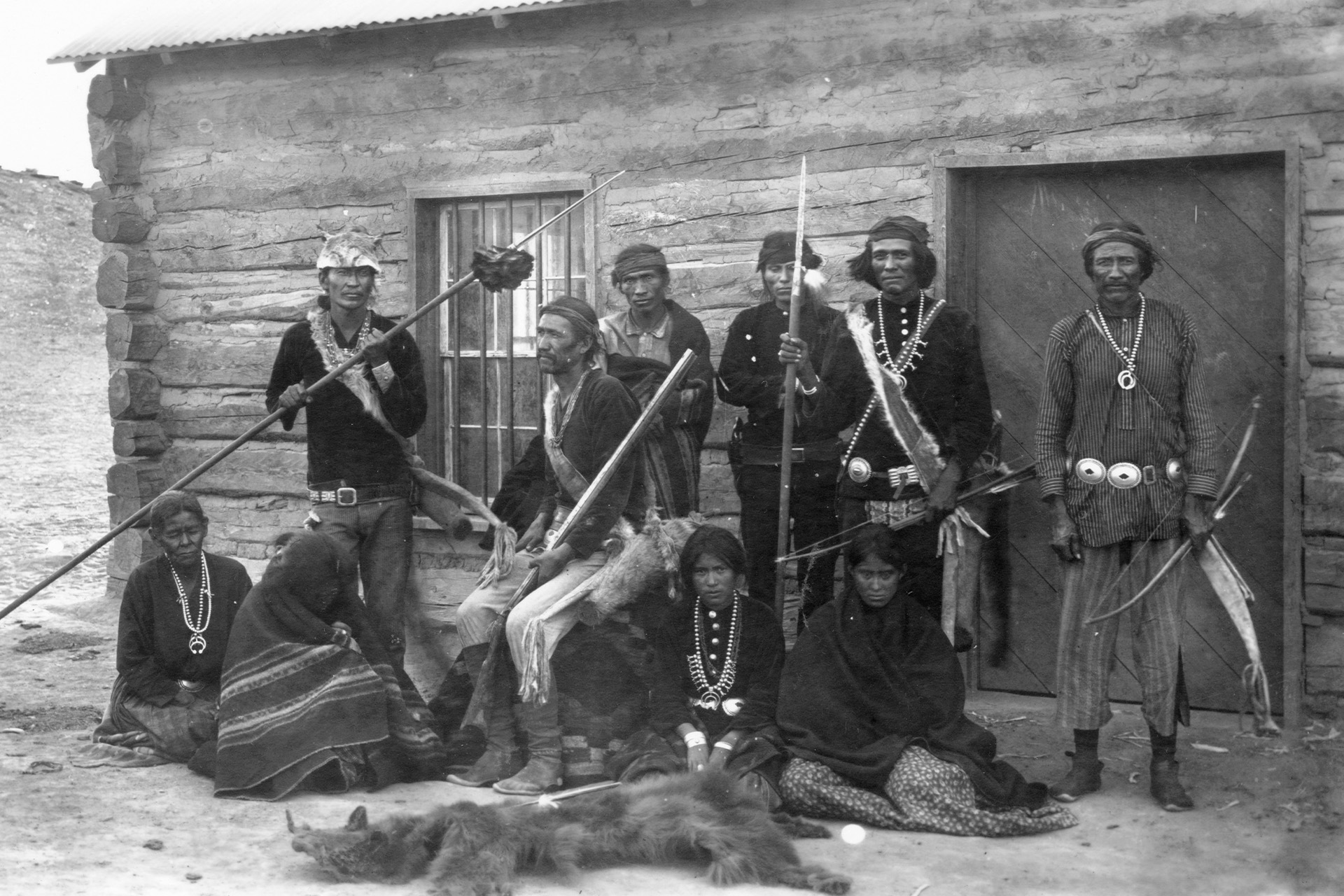
Conchos
Spanish Colonial buckles, with their scalloped and perforated edges, influenced the design of Navajo conchos. It has long been thought that early Navajo smiths copied this form. A copperSpanish buckle found at a Navajo site that dated to 1750 indicates the Navajo smiths’ long association with the form.
The diamond-shaped centers of early concho belts allowed the leather belt to pass through and secure the concho. Previous scholars proposed that Navajo smiths created conchos with open centers because they lacked the soldering skills required to attach a belt loop to the backs. However, Long Moustache, one of the pioneer Navajo smiths who learned from Atsidi Sani (the first known Navajo silversmith), related firsthand knowledge of soldering in the early days of the craft.
Bow Guards
Anyone who has ever used a bow understands the need for a wrist guard. Leather wrist guards were used by archers in the Native Southwest as well. Derived from the Navajo term for bow guards, they have come to be known as ketohs or gatos. Ethnographers in the late 1870s and1880s reported heavy leather wristlets mounted with silver disks. At Zuni Pueblo, bow guards decorated with pieces of tin arranged as pairs of panels or as a plate bearing simple cutouts were collected in 1879. Both forms occurred with small crimped-on additions along the edges of the leather foundation. This style was later reproduced in silver.
As the availability of silver increased, so did the size of the silver mounted bow guards, acquiring a rectangular shape covering the top of the wrist. The disk form still observed in period photos from the 1890s was eventually abandoned in favor of the larger format, giving silversmiths greater opportunity to showcase their decorative techniques.
While the Navajo smiths gained their knowledge of metalworking through Anglo-European contact, they needed look no further than the looms of the Navajo women for design inspiration. The developmental aspect of design seen particularly in bow guards coincides very visibly with changes in Navajo weaving patterns.
In the ensuing decades, bow guard design would expand and change along with other forms of jewelry. Smiths created skillfully stamped and repousséd ketohs, along with intricate sand-cast designs often having single and multiple settings of turquoise. Zuni smiths embellished their work with images borrowed from their rich cultural heritage, creating beautiful examples in silver and stone.
